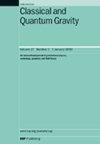从自旋泡沫看黑洞到白洞几何转换的特征时间尺度
IF 3.6
3区 物理与天体物理
Q2 ASTRONOMY & ASTROPHYSICS
引用次数: 0
摘要
度量的量子波动可能为黑洞过渡到白洞几何提供了一种衰变机制。之前的研究制定了环量子引力振幅,以期描述这一过程。我们确定了两个需要提取的时间尺度,称之为穿越时间和寿命,并完成了一项计算,利用 EPRL 模型的渐近学给出了明确的估计值。我们发现穿越时间与质量成线性关系,这与 Ambrus 和 Hájíček 以前的结果以及 Barceló、Carballo-Rubio 和 Garay 最近的结果一致。研究发现,寿命取决于量子态的扩散,因此它与质量的关系可以有很大的取值范围。这表明,这里使用的截断/近似方法并不适合对这一观测指标进行精确估算。最简单的平衡半经典态选择表明,其寿命与质量平方成指数缩放关系。我们的分析只考虑了没有体面的 2-复合物,这是一个很大的局限。特别是,我们还不清楚我们的估计值在细化后会受到怎样的影响。这项工作应被理解为在协变环量子引力的背景下向更全面计算迈出的一步。本文章由计算机程序翻译,如有差异,请以英文原文为准。
Characteristic time scales for the geometry transition of a black hole to a white hole from spinfoams
Quantum fluctuations of the metric may provide a decay mechanism for black holes through a transition to a white hole geometry. Previous studies formulated Loop Quantum Gravity amplitudes with a view to describe this process. We identify two timescales to be extracted which we call the crossing time and the lifetime and complete a calculation that gives explicit estimates using the asymptotics of the EPRL model. The crossing time is found to scale linearly in the mass, in agreement with previous results by Ambrus and Hájíček and more recent results by Barceló, Carballo–Rubio and Garay. The lifetime is found to depend instead on the spread of the quantum state, and thus its dependence on the mass can take a large range of values. This indicates that the truncation/approximation used here is not appropriate to estimate this observable with any certainty. The simplest choice of a balanced semiclassical state is shown to yield an exponential scaling of the lifetime in the mass squared. Our analysis only considers 2-complexes without bulk faces, a significant limitation. In particular it is not clear how our estimates will be affected under refinements. This work should be understood as a step towards a fuller calculation in the context of covariant Loop Quantum Gravity.
求助全文
通过发布文献求助,成功后即可免费获取论文全文。
去求助
来源期刊

Classical and Quantum Gravity
物理-天文与天体物理
CiteScore
7.00
自引率
8.60%
发文量
301
审稿时长
2-4 weeks
期刊介绍:
Classical and Quantum Gravity is an established journal for physicists, mathematicians and cosmologists in the fields of gravitation and the theory of spacetime. The journal is now the acknowledged world leader in classical relativity and all areas of quantum gravity.
 求助内容:
求助内容: 应助结果提醒方式:
应助结果提醒方式:


